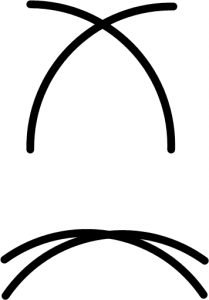Drafting the Astrolabe: Concerning Accuracy
- on 01.04.12
- Astrolabe Project, Drafting The Astrolabe, Tools
- No Comments
When using the Compass to measure distances, it is easier to transfer large distances than small ones with accuracy. If I need to draw a line and mark a point 1/32 of the way along it, I can do this with good accuracy by repeatedly dividing the line in half by construction. But if I want to transfer that 1/32 distance, it is easier and more accurate to transfer the 31/32 measurement. The mark ends up in the same place, but adjusting the compass accurately is easier.
When dividing a circle it is better to work each stage in the division over the whole circle then move to the next. If I need to divide a circle into 24 sections, I should first quarter the whole circle, then trisect all four quarters, then bisect all twelve sections. I could try to save time by trisecting one quarter, and bisecting one section of that; then use the compass to copy the arc of that 1/24 section 24 times. But I find that small errors in measurement compound if you do it that way. Working the whole circle at once tends to cancel out small errors.
